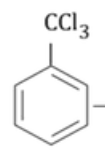[P]Br2−−→C2H4Br2NaNH2−−−−→Q20%H2SO4−−−−−−→RZnHg/HCl−−−−−−→S
The species P, Q, R and S respectively are
ethene, ethyne, ethanal, ethane
ethane, ethyne, ethanal, ethene
ethene, ethyne, ethanal, ethanol
ethyne, ethane, ethene, ethanal
The correct Answer is:A
To solve the problem, we will analyze each step of the reaction sequence provided in the question.
1. Identify the starting compound (P):
The first reaction involves the addition of bromine (Br₂) to compound P, resulting in C₂H₄Br₂. Since bromine adds across a double bond, compound P must be an alkene. The simplest alkene that can yield C₂H₄Br₂ upon bromination is ethene (C₂H₄).
Thus, P = C₂H₄ (Ethene).
2. Determine compound Q:
The next step involves treating C₂H₄Br₂ with sodium amide (NaNH₂). This reaction typically leads to the formation of an alkyne by dehydrohalogenation. In this case, the removal of two bromine atoms and the formation of a triple bond occurs, resulting in ethyne (C₂H₂).
Thus, Q = C₂H₂ (Ethyne).
3. Identify compound R:
The next reaction involves treating ethyne (Q) with 20% H₂SO₄ in the presence of mercuric ion (Hg²⁺). This reaction is known as the hydration of alkynes, which leads to the formation of an aldehyde. The product formed from ethyne under these conditions is acetaldehyde (C₂H₄O).
Thus, R = C₂H₄O (Acetaldehyde).
4. Determine compound S:
Finally, the acetaldehyde (R) is treated with zinc amalgam (Zn/Hg) and hydrochloric acid (HCl). This reaction is a reduction process, which will convert the aldehyde into an alkane. The product of this reduction will be ethane (C₂H₆).
Thus, S = C₂H₆ (Ethane).
Summary of the Species:
- P = C₂H₄ (Ethene)
- Q = C₂H₂ (Ethyne)
- R = C₂H₄O (Acetaldehyde)
- S = C₂H₆ (Ethane)
Final Answer:
The species P, Q, R, and S respectively are:
- P: Ethene (C₂H₄)
- Q: Ethyne (C₂H₂)
- R: Acetaldehyde (C₂H₄O)
- S: Ethane (C₂H₆)
The first reaction involves the addition of bromine (Br₂) to compound P, resulting in C₂H₄Br₂. Since bromine adds across a double bond, compound P must be an alkene. The simplest alkene that can yield C₂H₄Br₂ upon bromination is ethene (C₂H₄).
The next step involves treating C₂H₄Br₂ with sodium amide (NaNH₂). This reaction typically leads to the formation of an alkyne by dehydrohalogenation. In this case, the removal of two bromine atoms and the formation of a triple bond occurs, resulting in ethyne (C₂H₂).
The next reaction involves treating ethyne (Q) with 20% H₂SO₄ in the presence of mercuric ion (Hg²⁺). This reaction is known as the hydration of alkynes, which leads to the formation of an aldehyde. The product formed from ethyne under these conditions is acetaldehyde (C₂H₄O).
Finally, the acetaldehyde (R) is treated with zinc amalgam (Zn/Hg) and hydrochloric acid (HCl). This reaction is a reduction process, which will convert the aldehyde into an alkane. The product of this reduction will be ethane (C₂H₆).
- P = C₂H₄ (Ethene)
- Q = C₂H₂ (Ethyne)
- R = C₂H₄O (Acetaldehyde)
- S = C₂H₆ (Ethane)
The species P, Q, R, and S respectively are:
- P: Ethene (C₂H₄)
- Q: Ethyne (C₂H₂)
- R: Acetaldehyde (C₂H₄O)
- S: Ethane (C₂H₆)
Similar Questions
Knowledge Check
H3C−C≡CH1.NaNH2−−−−−−−→2.CH3CH2BrAH2−−−−−−→Pd−BaSO4B :
AA is H3C−CH2−C≡CHBA is CH3−C≡C−CH2CH3C D
D
C2H5BrAgCN−−−→XReduction−−−−−−−−→Zn−Hg/HCIY, Here, Y is:-
View SolutionCH≡CHNaNH2−−−−→[A]CH3Br−−−→[B]
View SolutionC2H2Hg(OH)21%−−−−−−−−−−→H2SO4A[O]−−→B, B is :
View Solution Br2−−→hv(A)alc. KOH−−−−→(B)OsO4−−→(C)HlO4−−→(D), Identify 'D'
Br2−−→hv(A)alc. KOH−−−−→(B)OsO4−−→(C)HlO4−−→(D), Identify 'D'
View SolutionC4H6H2+Pt−−−−→1molC4H8O3/H2O−−−−→ Acedic acid
(A) and (B), respectively, are:
View SolutionH−C≡C−HHgSO4−−−−−−→H2SO4dil.NaOH−−−−−→Δ−−→P. The final product P is
View Solution Ca(OH)2(aq)−−−−−−−−−→ANH3/Δ−−−−−−−→Br2+NaOHBBr2/H2O−−−−−→C
Ca(OH)2(aq)−−−−−−−−−→ANH3/Δ−−−−−−−→Br2+NaOHBBr2/H2O−−−−−→C
In the above sequence, C is
View Solution

_S01_475_Q01.png)